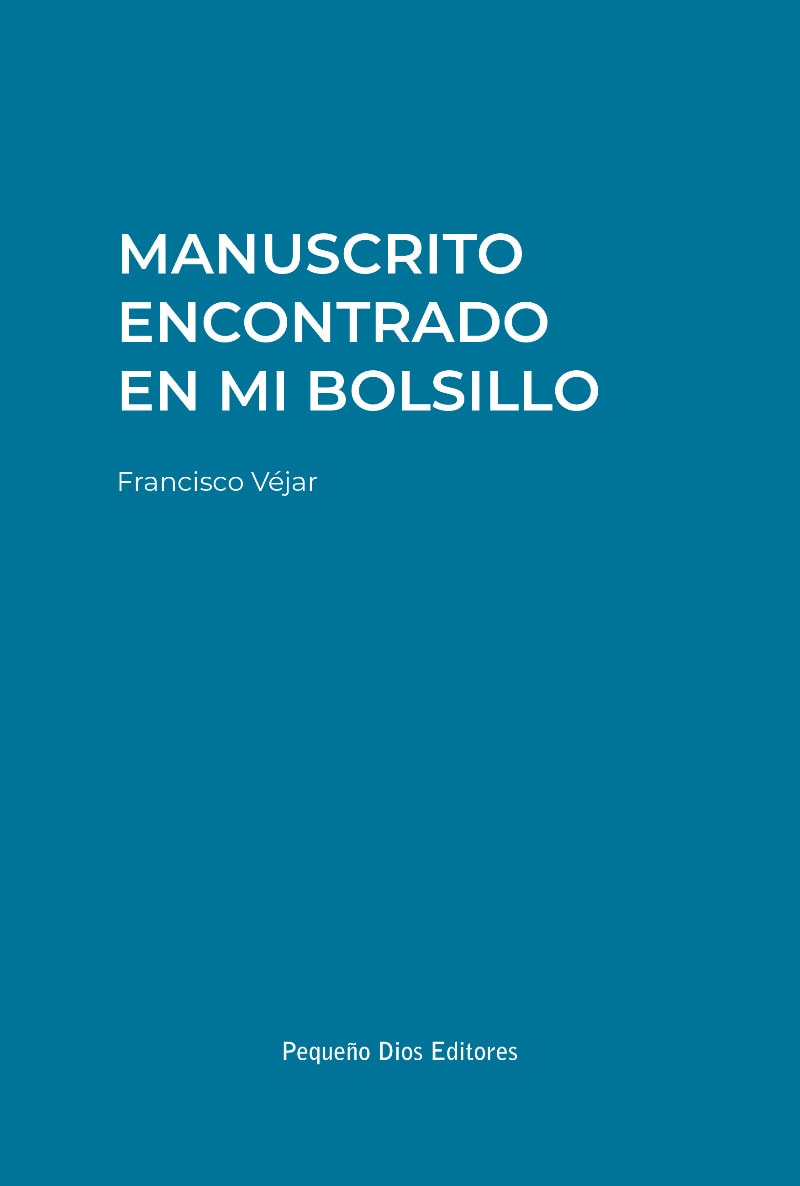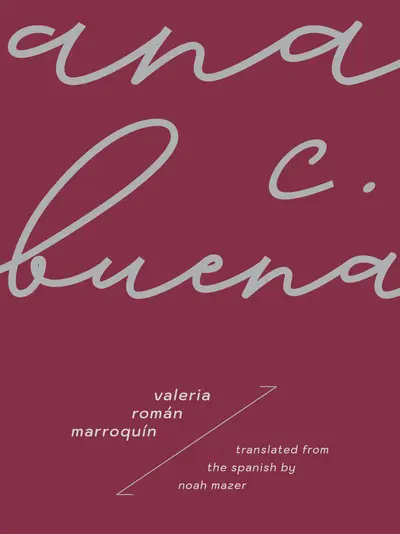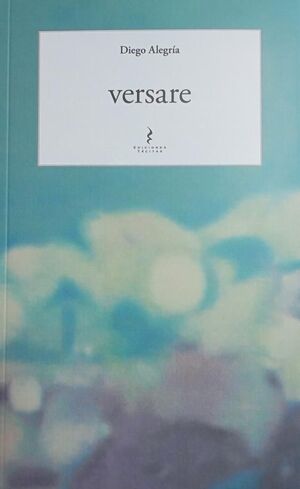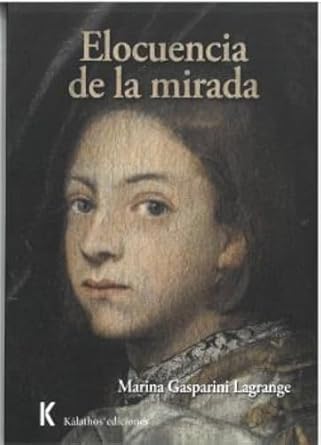Santiago: Pequeño Dios Editores. 2022. 48 pages.
 The poetry of Francisco Véjar is the height of romanticism in an era of cynicism. The speaker, in his Manuscrito encontrado en mi bolsillo (Pequeño Dios Editores), seeks meaning in the simplest images, such as trees and birds and the sea, the latter in particular, since it is “nuestro refugio. / Es la única piedra filosofal / que poseemos” [our refuge. / It is the only philosopher’s stone / that we possess]. At the same time, happily, the speaker can make fun of himself, as when he and his fellow writers spread out their poems on a barroom table and “la brisa marina insiste / en desordenar las hojas” [the sea breeze insists / on mixing up the pages]. In another poem he even says that “Nuestra virtud—por ahora—es saber reír” [Our virtue—for now—is to know how to laugh]. This sense of humor saves him from taking too seriously his romantic inclinations, or even delusions. The collection’s title itself even hints at the poet’s ability to offer a realistic perspective amid a type of dream world in which he wanders in search of meaningful encounters with nature and with the often-indifferent urban environment.
The poetry of Francisco Véjar is the height of romanticism in an era of cynicism. The speaker, in his Manuscrito encontrado en mi bolsillo (Pequeño Dios Editores), seeks meaning in the simplest images, such as trees and birds and the sea, the latter in particular, since it is “nuestro refugio. / Es la única piedra filosofal / que poseemos” [our refuge. / It is the only philosopher’s stone / that we possess]. At the same time, happily, the speaker can make fun of himself, as when he and his fellow writers spread out their poems on a barroom table and “la brisa marina insiste / en desordenar las hojas” [the sea breeze insists / on mixing up the pages]. In another poem he even says that “Nuestra virtud—por ahora—es saber reír” [Our virtue—for now—is to know how to laugh]. This sense of humor saves him from taking too seriously his romantic inclinations, or even delusions. The collection’s title itself even hints at the poet’s ability to offer a realistic perspective amid a type of dream world in which he wanders in search of meaningful encounters with nature and with the often-indifferent urban environment.
The word “refugio” appears in a number of Véjar’s poems and reflects the speaker’s need for some type of safe haven from the storms of life. The loss of a loved one has left him living in the remembered past, as is characteristic of the romantic. Nevertheless, there is always a poem like “El último metro” that effectively combines romanticism with realism. In this case, the speaker observes the young subway passengers sitting on their backpacks, reading Hannah Arendt, dreaming of breakfast at Tiffany’s, or heading for the barricades. Through this sympathetically rendered scene, the speaker turns an everyday event into a universal experience: “Las puertas del tren se abren, / las puertas del tren se cierran. / Unos entran y otros salen. / Así es la vida” [The train doors open, / the train doors close. / Such is life]. Despite the melancholy that permeates the poems, the speaker does find sanctuary in writing his poems, in listening to jazz, or recalling his loved one and their time together. In one section of a poem entitled “Historia de una fotografía,” the speaker sums up the photograph’s history with telling details:
Todos los recuerdos agrupados en una desgastada caja
en la que ella ha puesto su nombre
para que cada segundo vuelva a vivir
a través del oleaje de los años:
el tinte escarlata de los atardeceres,
horas en los restaurantes
dibujando el rostro amado en una servilleta.
[All the memories gathered up in a worn box
on which she has placed her name
so that each second it may return to life
through the tidal waves of the years:
the scarlet ink of the late afternoons,
hours in the restaurants
drawing on a napkin the beloved face.]
The “she” in the photograph poem may be the same figure who appears in the poem entitled “Lo único real.” The poet compares her red lips to the breast of a singing Chilean bird (la loica) and says that she will always be “el divinum vinum” [the divine wine]. This poem, like others in the chapbook, has a circular structure that begins with reference to the pair as a luxuriant road and ends with the same image, with the difference that the road is now said to be one on which the speaker loses himself to find himself. The “she,” who is also called “Amiga de tantos años inolvidables” [Friend of so many unforgettable years], is for the speaker the only reality in his life, which of course is the most romantic concept of all, but even so, the details of this poem and its circular structure support the claim that only the loved one brought meaning to his existence.
A poem that concerns the romantic theme of immutablity is entitled “Lo que quedará de nosotros,” and lists several items that the poet asserts will continue in perpetuity:
La búsqueda de ciertas calles.
Los primeros días del verano.
Viajes por cielos desconocidos.
Voces escondidas en algún rincón del espejo.
Líneas de un epitafio en la tumba de nuestros padres.
Lucy in the Sky with Diamonds.
Una carta arrojada al mar.
[The search for certain streets.
The first days of summer.
Voyages through unknown skies.
Voices hidden in some corner of the mirror.
Lines of an epitaph on the tomb of our parents.
Lucy in the Sky with Diamonds.
A letter thrown to the sea.]
Perhaps they will, for certainly all are totally romantic: certain remembered places, the first summer days, both unknown skies and Lucy in the Sky, a mirror, epitaphs of parents, and a letter (or a message in a bottle?) thrown in the sea. The realist would probably say that Véjar’s list is “pie in the sky,” but it is undeniable that he has come up with images that epitomize the romantic in terms of a perpetuation of moments in life that are meaningful in one way or another to anyone.
“Throughout the chapbook, the reader feels that the poet is revisiting moments in his life that have been described with accuracy and care”
Romantic love naturally shows up in Véjar’s poetry. A poem entitled “Cuarto de hotel” tells us outright in the first line that happiness was a hotel room found by chance. Is love not always found in this way? The poet reveals both the mysteries of such discoveries and, in his next statement, the reality in or of that room that was replaced by the beloved’s body. The speaker remembers again the room that became a small Paradise, where time no longer seemed to exist, after their having drunk a Chardonnay and shining with sweat. The speaker keeps telling the beloved that he must be dreaming, as the Metro steam rises through the grating and the afternoon dies at their feet. This description is real and completely believable, despite its romantic subject matter. The poem recreates an idealized encounter that the reader can take as true, and without any reliance on an overtly sexual portrayal of the amorous relationship.
Throughout the chapbook, the reader feels that the poet is revisiting moments in his life that have been described with accuracy and care. His descriptions of places bring them alive and reveal their significance, not only for the writer but for any reader who enters the poetry’s rich visual and suggestive language. I will leave the reader with an excerpt from a poem entitled “La vibración del río sobre el parque,” with its clear and beautifully pictorial images of the capital of Chile and its river that flows through the city like a scar:
Es extraño estar aquí y oír el grito de las gaviotas
que caen inciertas sobre el agua.
Esperar una barcaza de madera
o la huida del sol en el océano.
Seis y media de la tarde en las riberas del Mapocho,
la cicatriz de Santiago.
[It is strange to be here and to hear the cry of the seagulls
that fall uncertain above the water.
To await a wooden barge
or the flight of the sun into the sea.
Six-thirty in the afternoon on the banks of the Mapocho,
the scar of Santiago.]





